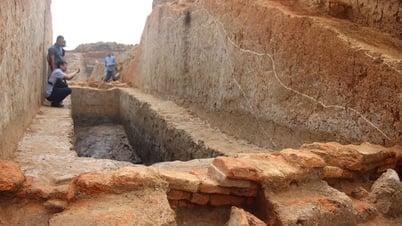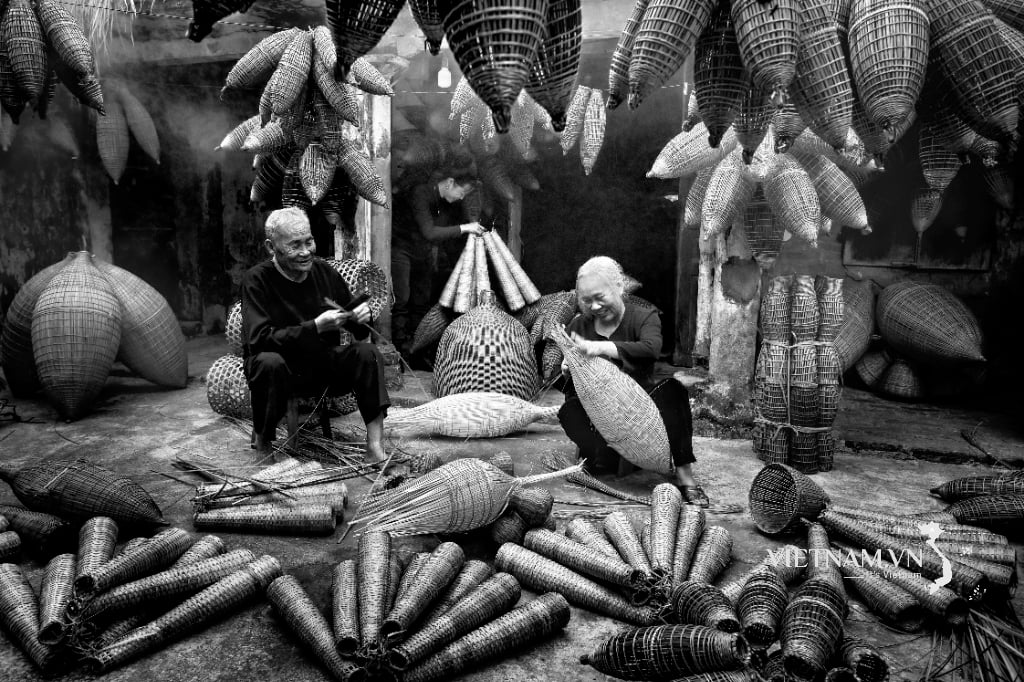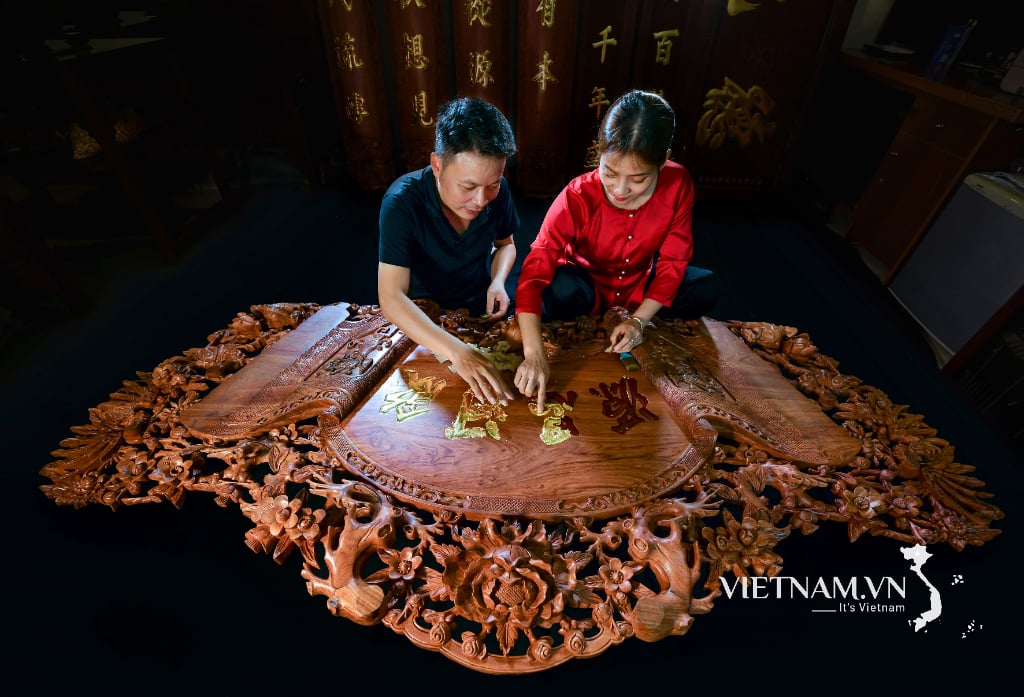Along with Tran Temple relic, Pho Minh Pagoda in Nam Dinh is one of the famous spiritual destinations, impressing visitors with its ancient, green and peaceful features. In particular, Pho Minh Pagoda is also a place to preserve many special national heritages.
Pho Minh Pagoda, also known as Thap Pagoda, is an ancient pagoda located in Tuc Mac village, Loc Vuong ward, Nam Dinh city, Nam Dinh province. Not only is it a unique architectural work, Pho Minh Pagoda is also the largest, oldest and most intact pagoda tower in Vietnam.
According to the reporter's research, Pho Minh Pagoda was built during the Ly Dynasty and expanded during the Tran Dynasty. The pagoda is a famous relic in the Hong Duc map drawn in 1470 and is considered a great scenic spot of Dai Viet. This is also one of the places where King Tran Nhan Tong practiced with monks Phap Loa and Huyen Quang.
After the death of King Tran Nhan Tong, the successor King Tran Anh Tong ordered people to make a stone palanquin and build a tower on top, then placed 7 of the 21 relics of his father in a precious stone box and brought them into the Pho Minh tower in front of the temple.

Pho Minh Pagoda, also known as Thap Pagoda, is an ancient pagoda located in Tuc Mac village, Loc Vuong ward, Nam Dinh city, Nam Dinh province.
Pho Minh Tower has 14 floors, 19.51m high. The two lowest floors are built of stone with carved lotus petal and water wave patterns. The 12 upper floors are built of exposed bricks, not plastered. Each end of the brick has the inscription "Hung Long Thap Tam Nien" (ie Hung Long 13th year/1305) and a relief dragon of the Tran Dynasty. The top of the tower has a stone block shaped like a lotus with many layers of petals.
The tower base is designed entirely of green stone, each side is 5.20m long. At the foot of the tower is a small lotus flower with petals, gradually tilting from the middle to the corner of the tower, symbolizing a lotus platform carrying a palanquin. The lower part of the stone pedestal is curved on both sides, making viewers easily mistaken that it is due to the subsidence of the stone, but in fact, it was built to create momentum for more than 10 floors above, all of which have similar curves.
The tower was built of red bricks with four doors in the four directions East, West, South, and North. The tower is surrounded by walls. In the middle of the walls is the entrance to the tower, decorated with pairs of stone dragons. At the foot of Pho Minh tower are two large incense sticks (also known as sutra pillars) made of stone, exquisitely crafted in the shape of lotus flowers.

Pho Minh Tower is a famous architectural work.
However, in the early 20th century, when it was renovated, people used cement material to cover the exterior of the tower, losing the patterns on the bricks.
Besides, the main architectural complex of the pagoda has the front hall and the upper hall. Behind the upper hall, separated by a narrow yard, is an 11-room long house. In the middle are 5 rooms for the ancestors, on the left are 3 rooms for monks and on the right are 3 rooms for worship.
The carvings and architecture inside the pagoda reflect many of the artistic and refined features of the Tran Dynasty. Two corridors connecting the front hall with the 11-room house at the back form a square frame surrounding the pagoda architecture. The carvings and architecture inside the pagoda reflect many of the artistic and refined features of the Tran Dynasty.
Pho Minh Pagoda worships Buddha like other pagodas. However, above all, this is a place of worship and has a close connection to the King - Buddha Emperor Tran Nhan Tong, who founded the Truc Lam Zen sect, making Pho Minh Pagoda a major religious center of Dai Viet nation.

The temple is keeping many heritages in Thanh Nam land.
Therefore, the pagoda is worshiping the three founders of the Truc Lam Zen sect founded by King Tran Nhan Tong under the Tran Dynasty. In the middle is a statue of King Tran Nhan Tong entering nirvana (lying on his side), his head resting on his left hand, his right hand stretched out and placed on his body, the whole statue is placed in a rectangular altar.
On the left of the Tran Nhan Tong statue is the statue of Phap Loa - the Second Patriarch of Truc Lam and on the right is the statue of Huyen Quang - the Third Patriarch of Truc Lam. The statues of the Three Patriarchs of Truc Lam at Pho Minh Pagoda date back to the 17th century, made of wood, lacquered red, and gilded. This is a national treasure recognized by the Government under Decision No. 41/QD-TTg dated January 30, 2023 signed by Deputy Prime Minister Tran Hong Ha.
Along with that, inside the pagoda complex there are ancient trees that are hundreds of years old but not everyone knows. Among them, there are two ancient Muom trees recognized as Heritage trees, determined to be over 300 years old.

Two Ebony trees are recognized as heritage trees.
According to documents, the two ancient Mượm trees have a majestic shape, round trunks, tree diameters at a height of 1m are 143cm and 114cm, the height of the top is 18.5 and 19m, there are many large branches with wide spreading canopies, the diameter of the canopy is 19.7 and 25.9m.
Today, although it has been over 300 years, the two Ebony trees in the grounds of Pho Minh Pagoda are still growing and developing well; the fruit is heavy and sweet. In particular, a Ebony tree on the left of Pho Minh Tower (in the direction of the pagoda) although the trunk and some branches are hollow, is still healthy, with lush green leaves.

The set of 4 doors with carved dragon images is currently installed in the middle room of the Front Hall, Pho Minh Pagoda.
The set of 4-panel doors with dragon carvings is currently installed in the middle room of the Front Hall, Pho Minh Pagoda, a version of the set of 4-panel doors (original artifact, dating back to the Tran Dynasty). Currently, the 2 middle panels (original artifact) are being preserved and displayed at the National History Museum. The 2 side panels (original artifact) are being displayed at the Nam Dinh Provincial Museum.
The door set consists of 4 panels and is made of ironwood, solid block, each panel is 1.90m high and 0.80m wide. The door set has been recognized by the Prime Minister as a National Treasure.

Pho Minh Tower on the 100 dong note.
In addition, the grounds of Pho Minh Pagoda still preserve stone railings carved with dragons dating back to the Tran Dynasty. Along with a hundred-year-old Banyan tree, the trunk has been punctured through the core, leaving only the bark of the tree remaining.
However, miraculously, the ancient banyan tree has remained green for many years. In the temple grounds, there is also a Dai tree planted in front of the tower that is hundreds of years old, with a large base, rough skin, wide canopy, and a trunk resembling a flying dragon.
It is known that in 2012, Pho Minh Pagoda was ranked as a special national monument. This is an important spiritual and tourist destination that attracts thousands of visitors every year. Pho Minh Pagoda is not only an ancient pagoda but also an impressive historical and cultural relic.
(According to 24h, January 28, 2024)
Source


























![[Photo] Overcoming the heat, practicing to prepare for the parade](https://vphoto.vietnam.vn/thumb/1200x675/vietnam/resource/IMAGE/2025/6/21/b93392e8da8243b8a32040d19590e048)






















![[Maritime News] Wan Hai Lines invests $150 million to buy 48,000 containers](https://vphoto.vietnam.vn/thumb/402x226/vietnam/resource/IMAGE/2025/6/20/c945a62aff624b4bb5c25e67e9bcc1cb)












































Comment (0)